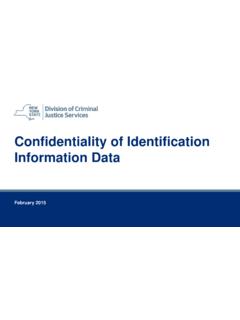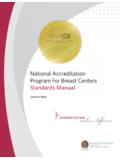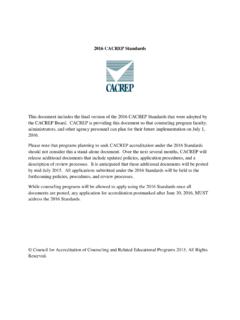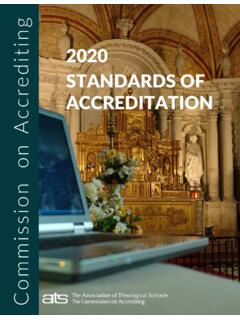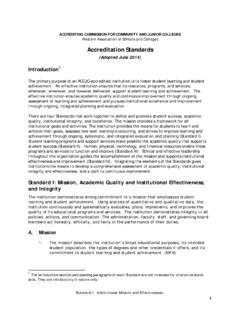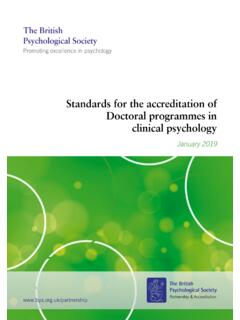Transcription of STANDARDS AND COMPLIANCE VERIFICATION MANUAL
1 New York State Division of Criminal Justice Services 80 South Swan Street, Albany, New York 12210 New York State Law Enforcement accreditation Program STANDARDS AND COMPLIANCE VERIFICATION MANUAL 8th Edition September 2015 Revision March 10, 2022 1 Prepared by New York State DIVISION OF CRIMINAL JUSTICE SERVICES Office of Public Safety COPYRIGHT NOTICE Copyright December 2021 by the New York State Division of Criminal Justice Services. You are hereby granted a non- exclusive license to use the enclosed materials for non-commercial use and to reproduce, copy, and/or distribute these materials for educational purposes related to the New York State Law Enforcement accreditation Program. The materials contained in this publication may be included in a non-commercial derivative work with proper attribution to the New York State Division of Criminal Justice Services. These materials may not be posted on a commercial or non- commercial Internet site without the prior written permission of the Division.
2 This non-exclusive license will be governed and construed in accordance with the laws of the State of New York. Published by the: New York State Division of Criminal Justice Services Office of Public Safety Alfred E. Smith State Office Building, 3rd Floor 80 South Swan Street Albany, New York 12210 PRINTED IN THE UNITED STATES OF AMERICA 8th Edition September 2015 Revision , March 10, 2022 2 The STANDARDS contained in this MANUAL have been approved by the New York State Law Enforcement Agency accreditation Council in accordance with the provisions of 846-h of the New York State Executive Law. The program is offered to the law enforcement community for use on a voluntary basis. The STANDARDS are not intended to replace or circumvent any legal requirement that may apply to individual agencies. The accreditation Council recognizes that state and local laws, Codes, Rules and Regulations, and current bargaining agreements are binding in nature and take precedence over program STANDARDS and definitions.
3 Key terms are defined in the Glossary beginning on page 164. These are offered solely for the purpose of clarifying the intended scope and purpose of program requirements. AUTHORITY AND DISCLAIMER3 Table of Contents LAW ENFORCEMENT AGENCY ACCREDITATIONPROGRAM OVERVIEW ..9 Program Basics .. 9 Composition of the STANDARDS .. 9 Becoming an Accredited Law Enforcement Agency .. 10 DCJS RESOURCES FOR AGENCIES SEEKING accreditation .. 13 COMPLIANCE AUDITS AND CRITICAL STANDARDS .. 16 CRITICAL STANDARDS .. 17 ADMINISTRATIVE STANDARDS .. 20 I. ADMINISTRATION .. 20 Section 1 Agency Role .. 22 1. 1 Mission .. 22 1. 2 Goals, Objectives and Evaluation of Goals .. 23 Section 2 Organization .. 24 2. 1 Organizational Structure .. 24 2. 2 Job Classifications .. 25 2. 3 Written Directives - CRITICAL STANDARD .. 26 Map of Patrol Areas .. 27 Responsibility and Authority - CRITICAL STANDARD .. 28 Section 3 Health and Safety .. 29 Infectious Diseases .. 29 Section 4 Officer Wellness.
4 30 Officer Wellness .. 30 ADMINISTRATION .. 31 Section 5 Fiscal Management .. 33 5. 2 Accounting System and Responsibility .. 34 5. 3 Safeguarding Cash - CRITICAL STANDARD .. 34 Section 6 Agency Property .. 35 Requisitioning Property .. 35 6. 2 Safeguarding Agency Weapons - CRITICAL STANDARD .. 36 Section 7 Non-Agency Property .. 37 4 7. 1 Evidence and Non-Agency Property Management - CRITICAL STANDARD .. 37 7. 2 Evidence Custodian Training .. 39 7. 3 Property Audit and Inventory Management - CRITICAL STANDARD .. 40 Section 8 - Records .. 42 8. 1 Calls for Service .. 42 8. 2 Crime Reporting .. 43 Records 44 Records Management System - CRITICAL STANDARD .. 45 8. 1 1 Sealing Orders .. 46 8. 1 2 Record System for Warrants .. 47 8. 1 3 Legal Process .. 48 Section 9 Reporting Requirements .. 49 Reporting Requirements CRITICAL 49 .. 50 Section 11 - Recruitment .. 52 Personnel Recruitment .. 52 Section 12 - Selection .. 53 Hiring STANDARDS CRITICAL STANDARD.
5 53 1 2. 6 Oral Interviews .. 54 1 2. 8 Probation .. 55 1 2. 9 Oath of Office .. 56 Section 13 Performance Evaluations .. 57 Performance Evaluation System - CRITICAL 57 Section 14 - Discipline .. 59 1 4. 1 Rules of Conduct - CRITICAL STANDARD .. 59 1 4. 2 Court Appearances .. 60 1 4. 3 Legislative Restrictions on Officers .. 61 1 4. 4 Disciplinary System - CRITICAL STANDARD .. 62 Sexual Harassment - CRITICAL STANDARD .. 63 Section 15 - Promotions .. 64 Promotional Process .. 64 Section 16 - Grievances .. 65 Grievance Procedures .. 65 Section 17 - Awards .. 66 Awards Procedures and Criteria .. 66 5 SECTION 18 Death or Serious Injury of Agency 67 Death or Serious Injury of Agency Personnel - Procedures .. 67 OF FORCE .. 69 Section 20 Use of Force .. 71 Use of Force: General - CRITICAL STANDARD .. 71 2 0. 5 Carrying of Firearms .. 72 2 0. 6 Less Lethal 73 Section 21 Agency Review .. 74 Review of Firearms Use .. 74 AFFAIRS .. 75 Section 25 Internal Affairs.
6 77 Internal Affairs Function - CRITICAL STANDARD .. 77 RELATIONS .. 79 Section 28 Public Information .. 81 Public Information Function and Media .. 81 Social Media .. 82 Section 29 Community Relations .. 83 Responsibility of Personnel .. 83 2 9. 3 Crime Prevention .. 84 2 9. 4 Crime Victims .. 85 2 9. 5 Sex Offense Victims .. 86 2 9. 6 Sex Offender Management .. 87 TRAINING STANDARDS .. 89 Section 32 - Basic .. 91 Basic Course for Police Officers - CRITCAL STANDARD .. 91 3 2. 3 Firearms Training .. 92 3 2. 4 Use of Less Lethal Substances/Devices .. 93 3 2. 5 Field Training .. 94 Section 33 In-Service .. 95 3 3. 1 Length and Content - CRITICAL STANDARD .. 95 3 3. 2 Instructor Qualifications .. 96 3 3. 3 Specialized Training .. 97 Section 34 Supervisory Training .. 98 3 4. 1 First-Line Supervisors .. 98 6 3 4. 2 Annual Supervisory Training .. 99 Section 35 Training Records .. 100 3 5. 1 Personnel Training Records .. 100 3 5. 2 Training Courses .. 101 3 5. 3 Agency Sponsored Courses.
7 102 OPERATIONAL STANDARDS .. 103 I. PATROL .. 103 Section 40 Patrol Functions .. 105 4 0. 1 Responsibilities of Patrol Officers .. 105 4 0. 2 Supervisor Responsibilities .. 106 4 0. 3 Command Protocol .. 107 Section 41 - Equipment .. 108 Vests .. 108 Authorized Apparel, Equipment and Identification .. 109 Section 42 Vehicles .. 110 Patrol Vehicles .. 110 4 2. 3 Seat Belts .. 111 4 2. 4 Special Purpose Vehicles .. 112 Section 43 - Activities .. 113 4 3. 1 Responding to Calls .. 113 4 3. 2 Recording Officer Status .. 114 4 3. 3 Law Enforcement Response .. 115 4 3. 4 Vehicle Pursuits - CRITICAL STANDARD .. 116 4 3. 5 Roadblocks .. 117 4 3. 6 Specialized Units .. 118 4 3. 7 Notifying Next of Kin .. 119 4 3. 8 Health of Persons in Custody 120 Section 44 Specialized Incidents .. 121 4 4. 1 Domestic Incidents - CRITICAL STANDARD .. 121 4 4. 2 Hate Crimes .. 122 4 4. 3 Missing Persons .. 123 II. TRAFFIC .. 124 Section 47 - Traffic .. 126 4 7. 1 Enforcement of Traffic Violations.
8 126 7 4 7. 2 Stopping Violators .. 127 4 7. 3 High Visibility Clothing .. 128 4 7. 4 Speed Measuring Devices .. 129 4 7. 5 Impaired and Intoxicated Driving Cases .. 130 4 7. 6 Hazardous Road Conditions .. 131 4 7. 7 Accident Reporting/Investigations .. 132 4 7. 8 Towing and Impoundment .. 133 III. CRIMINAL 134 Section 50 Methods .. 136 Criminal Investigations CRITICAL STANDARD .. 136 5 0. 4 Juvenile Operations .. 137 5 0. 5 Informants .. 138 5 0. 6 Aids for Detecting Deception .. 139 5 0. 7 Intelligence Collection and Sharing .. 140 5 0. 8 Fingerprinting and Photographing Defendants .. 141 5 0. 9 DNA Databank .. 142 Section 51 Scenes of Incidents .. 143 5 1. 1 Processing Scenes .. 143 5 1. 2 Equipment .. 144 5 1. 3 Photographs .. 145 Incident Reports .. 146 IV. COMMUNICATIONS .. 148 Section 55 - Communications .. 149 Communications - Responsibilities and Procedures .. 150 5 5. 3 Two-Way Radios .. 151 5 5. 4 Communication with Patrol Officers .. 152 5 5. 5 Intra-Agency Cooperation.
9 153 V. UNUSUAL OCCURRENCES .. 154 Section 58 Unusual Occurrences .. 156 5 8. 1 Mutual Aid .. 156 5 8. 2 Disaster Plans - CRITICAL STANDARD .. 157 5 8. 3 Continuity of Operations Plan (COOP) .. 158 5 8. 4 Emergency Mobilization Plan .. 159 VI. PRISONER TRANSPORT .. 160 8 Section 64 Prisoner Transport .. 162 6 4. 1 Prisoner Transport and Safety .. 162 LAW ENFORCEMENT AGENCY accreditation PROGRAM OVERVIEW Program Basics The New York State Law Enforcement Agency accreditation Program was established as a voluntary program that would provide law enforcement agencies with a mechanism to evaluate and improve the overall effectiveness of their agency and the performance of their staff. accreditation is formal recognition that an agency s policies and practices meet or exceed the STANDARDS established by the council in the areas of administration, training, and operations. Article 36, 846-h of the New York State Executive Law establishes the Law Enforcement Agency accreditation Council (the council).
10 The council is the authoritative body responsible for guiding the direction of the program; developing model STANDARDS designed to promote excellence and professionalism in the field of law enforcement; and developing policy to establish program rules and expectations. The council meets quarterly to conduct business, including awarding accreditation to agencies that have demonstrated that they meet the program requirements and are compliant with the STANDARDS . The Division of Criminal Justice Services (DCJS) Office of Public Safety (OPS) administers the program in accordance with the council policies. accreditation Unit staff members provide training to members of agencies seeking to become accredited; and to assessors, who are independent contractors assigned to verify an agency s COMPLIANCE with program STANDARDS . In addition, OPS program staff members develop resource materials; provide technical assistance to both applicant and accredit ed agencies to assist them in meeting their goals; conduct site visits of accredited agencies; and provide support -staff services to the council.








